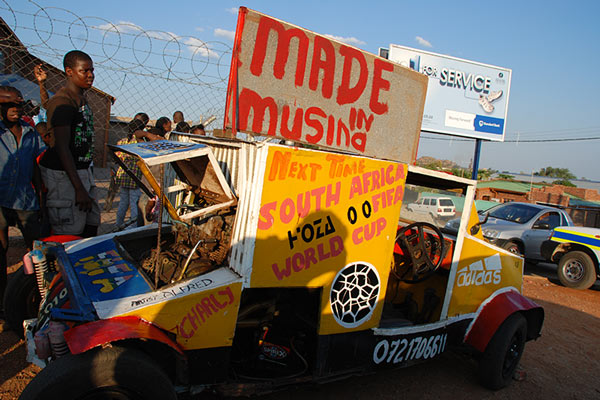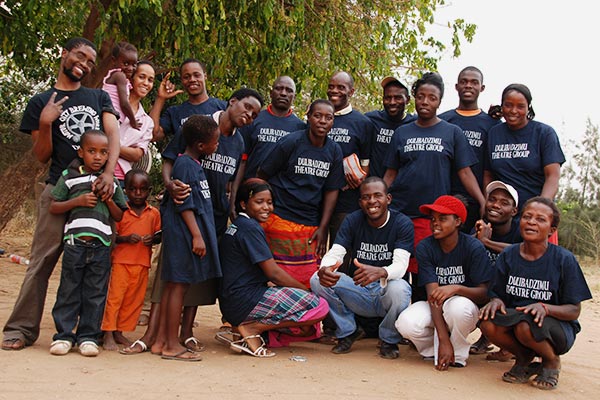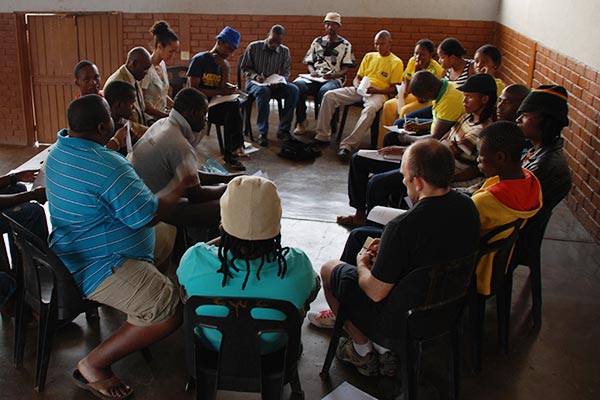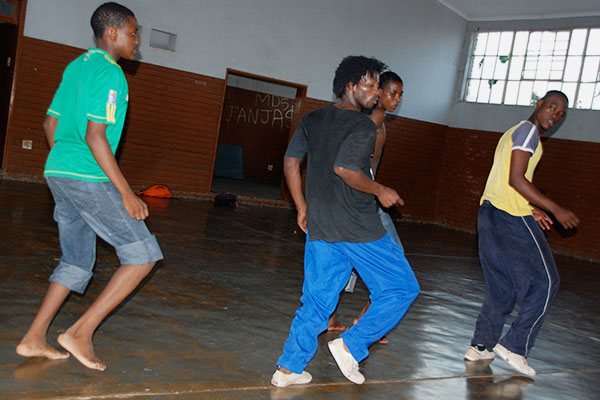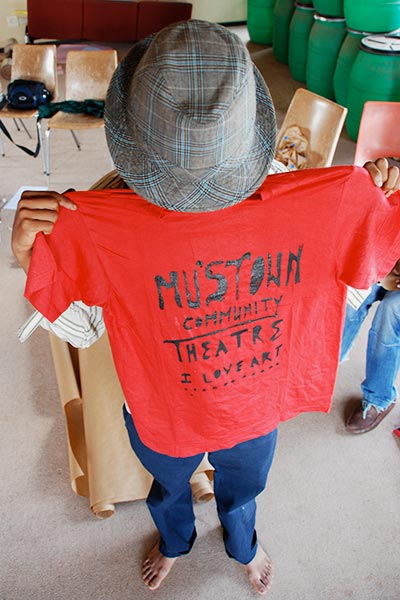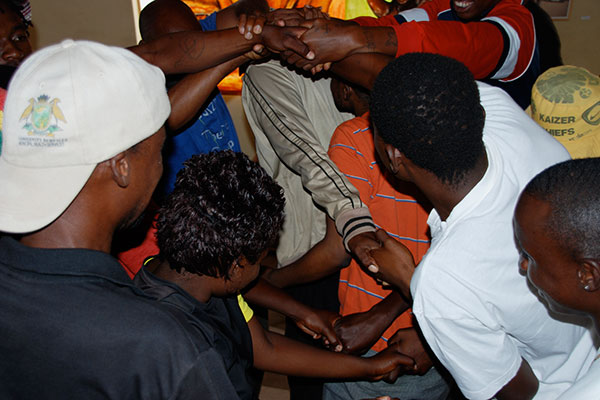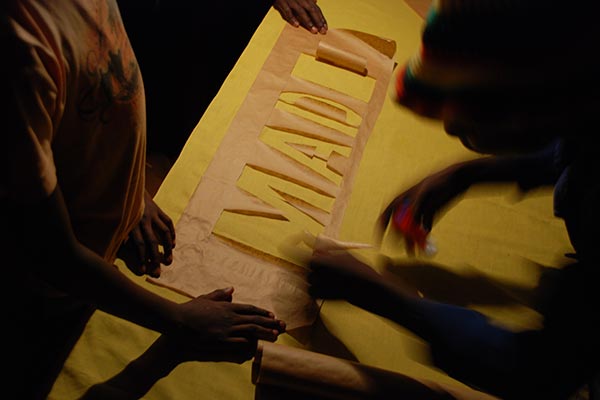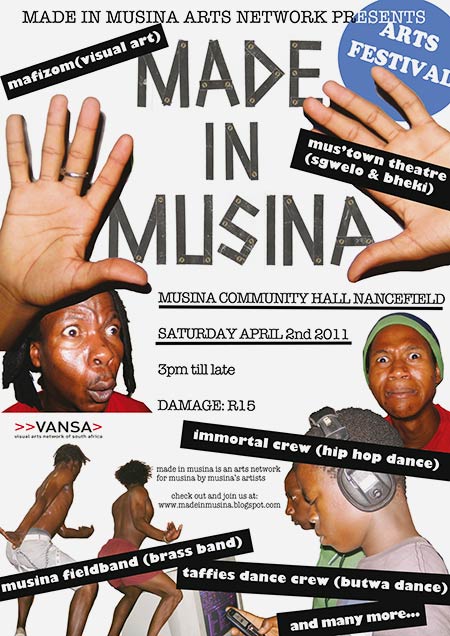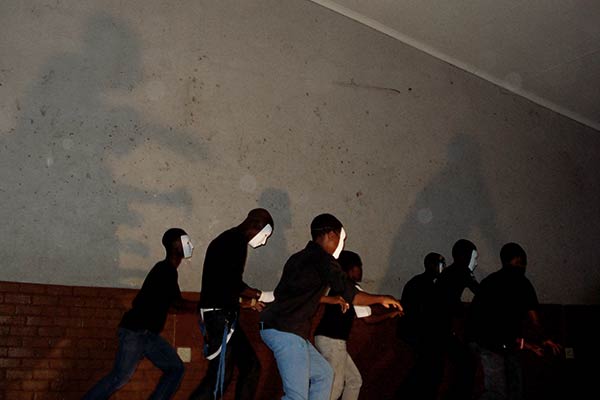The “Made In Musina” Project
The MADE IN MUSINA Project aimed to create a living arts network linking the artists in the border town of Musina, providing them with access to information about the arts and showcasing and promoting Musina’s artistic talent.
The idea of creating an arts network emerged from conversations that a group of Johannesburg based artists had with young artists in Musina, who said they felt isolated in terms of access to information and opportunities, and sorely lacked an organised arts community.
Over a period of six months, the Johannesburg artists facilitated and directed the process of building the network, with a core group of young leaders that emerged. Together they worked towards the first MADE IN MUSINA Arts Festival. These leaders formed the MADE IN MUSINA action committee, which completely took complete control of the network, as the Johannesburg artists gradually reduced their direct leadership involvement.
A year later, the MADE IN MUSINA Arts Network is functioning as the only arts organization organizing and mobilizing artists in Musina. The Johannesburg artists remain involved with network project as mentors.
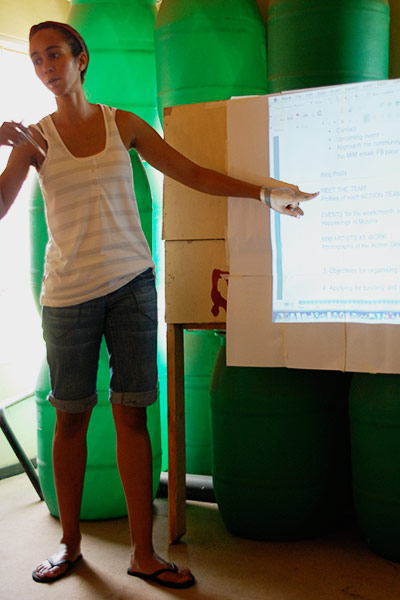
Project coordinator and co-initiator Thenjiwe Nkosi
BACKGROUND
MADE IN MUSINA developed out of Border Farm, a collaborative art project at Maroi Farm on the border of South Africa and Zimbabwe by Thenjiwe Nkosi. The formation of the Dulibadzimu Theatre group was the main goal of the Border Farm project, and the group was formed through talking and making art together about experiences of migrancy and exile. The final artistic outcome of the project was a film, which emerged from a series of workshops in photo, writing and acting. These workshops were designed to encourage group cohesiveness and to build art and filmmaking skills. MADE IN MUSINA grew out of a desire to link the Dulibadzimu Theatre Group to the arts community in town, and an interest in seeing if a similar collaborative project would be possible among the artists of Musina. But first we needed to find out what was going on in Musina...

MADE IN MUSINA Arts Festival planning
A NETWORK
After an arts community meeting in late 2011, it became clear that MADE IN MUSINA could be a means of beginning to collectively develop and expose what Musina has to offer. What emerged from discussions is the idea that this border town has a lot of energy, talent and activity, but that it is all very isolated and unknown to potential audiences. We were curious at the idea of collaborations, and discovered that a small town does not embrace such practice as the pie is too small. From the first community meeting (a spectrum of artists attended) – it became clear that a network would be the most useful long-term thing that we could be part of establishing. We became interested in the idea of facilitating collaboration and networking between organizations in the largely fragmented arts community. How do we create a network? Is it a visual art thing to create a network? How is the creation of a network public? It was a first time experience for us, and far from our original idea. We learned, re-learned and unlearned a lot during and through the process.
We met a wide range of Musina residents; artists, legal and social NGO’s, municipal employees, farmworkers. Our discussions attempted to understand the state of Musina arts, what people are making, how they do things, support, challenges, dreams and ideas. The process of research helped us get a clearer idea of what MADE IN MUSINA was to be become, develop a loose structure as well as plans of action for both the MADE IN MUSINA organizers and the Musina arts leadership.
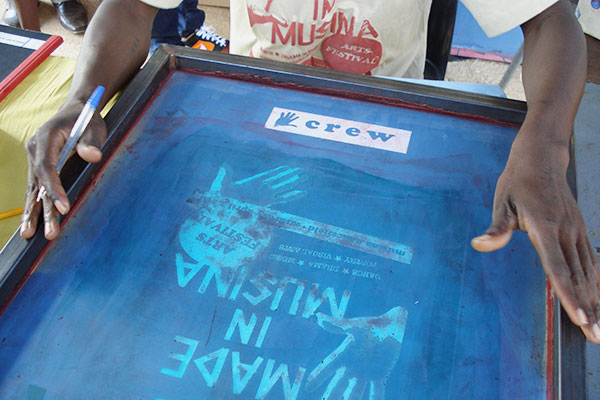
T-shirt printing workshop for Arts Festival
The idea of a network can be complex, and can also be abstract as it is informed by people’s experiences, circumstances, age and lifestyle. To build a network and make its relevance obvious involved plenty of trial and error. We used a series of activities from which discussions would emerge, and the point to be clearer.
The t-shirt printing workshop was a literal demonstration of a network. It was imagined as a practical viral tool to initiate interest and dialogue about MADE IN MUSINA. Subsequent activities became more complex, involving task sharing and development of roles. This process led to a decrease in membership, distilled the participants to a leaner team of co-organisers. This required for further definition of MADE IN MUSINA and the development of the first project of MADE IN MUSINA, Musina Arts Festival.
The idea was to use workshops to help us achieve these goals. The workshops covered: blog creation and maintenance, organizational structuring and profiling, defining goals and implementing action plans, applying for funding/sponsorship and sustainability. The skills transferred in these workshops all had practical application as we applied them directly to the activities of the project (e.g. we applied for a grant together for the festival and we collectively implemented a plan of action.)
The festival brought groups together under the aegis of the MADE IN MUSINA network, and was planned with a spirit of collaboration and communication - which is particularly important in an environment where there is much competition amongst artists/arts organisations. It took place inside and outside the Musina Nancefield Commmunity Hall, incorporating performance, live t-shirt printing and a street parade.
With over 300 people attending the festival, its sustainability (as an annual event) seemed promising from the feedback received to the call for applications. The MIM Arts Network seeks to fulfill that demand as part of its mission. It is clear that artists are eager for forums to showcase their work, and for attention to be given to the arts. Thus, MIM’s work continues, expanding the size and reach of their activities as the organisation grows.

Arts Festival street parade on the move
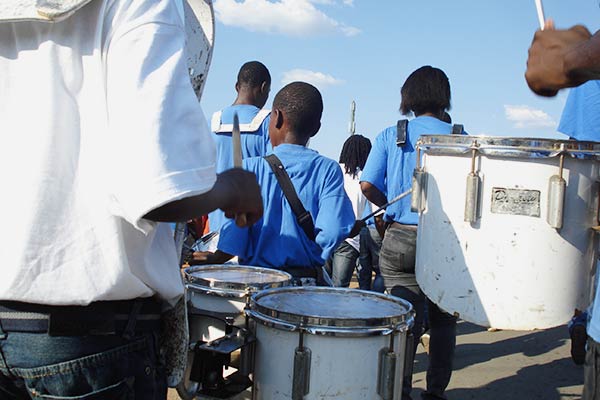
Arts Festival street parade band
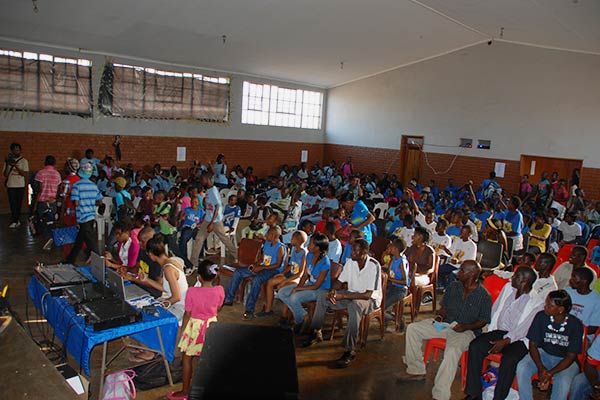
Audience waiting for the performances at the Musina Nancefield Commmunity Hall
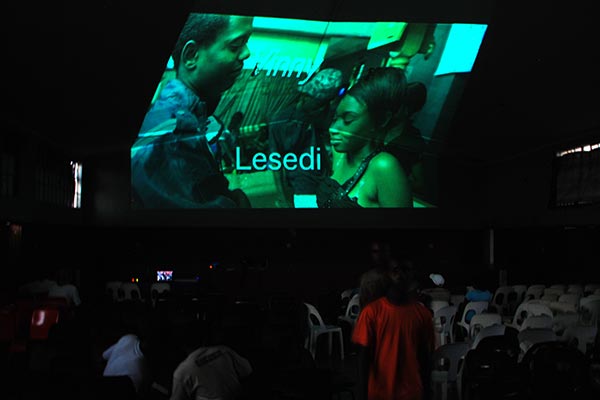
Film screening at Musina Nancefield Commmunity Hall
The MIM Arts Network has also created the first actively growing database of all the artists/arts organisations in Musina. In the process of creating this database, they have been teaching artists/arts organisations how to write organisational profiles by giving them a template to work from.
MIM TODAY
These leaders formed an action committee that took control of the network as Rangoato and Thenjiwe have gradually reduced their direct involvement. Two years later, the MIM Arts Network is the only arts organisation mobilizing and informing artists in Musina. Rangoato and Thenjiwe remain involved in a mentoring capacity.
RELATED WEB SITES
→ Made in Musina Arts Network
→ Made in Musina web-site
[ 2nd May ]
[ Al Kheimah—The Tent ]
[ Al Maq’ad—The Bench ]
[ Altelefon Alkharban—Téléphone Cassé ]
[ El Ashaa’—The Banquet ]
[ El Matam El Mish Masry ]
[ Ez-zahr—The Dice ]
[ Flatlands Av. ]
[ Here I Stand ]
[ In Memory of Protest ]
[ In the Shadow of the Pyramids ]
[ Mels - A Pause For Thought ]
[ Schaffhauser Rheinufer ]
[ Shwayet mayy—Some Water ]
• The “Made In Musina” Project •
[ urbaninform ]
[ WAM _ World Agricultural Museum ]
FEATURED THEME ON CITY SHARING
by ASUNCION MOLINOS GORDO
-
This project is an instrument for common critical analysis to help understand the reasons behind Egyptians’ diminishing …
by INAS HALABI
-
The project Letters to Fritz and Paul focuses on the expeditions of the Swiss cousins, lovers and scientists, Fritz and …
by SARAH BURGER
-
The planned modern city of Brasilia attracted me since a long time. Her defined shape, location and function proceded he …
by ADRIEN GUILLET
-
Youri Telliug talks with the artist Adrien Guillet about his project Citracit
Youri Telliug - What is Citracit …
by NIGIST GOYTOM
-
In 2013 more than 45 million people have been forced to leave their homes. This amounts to the biggest number of refugees …
by SULAFA HIJAZI
-
The on going debate on Arab identity and its (cultural) representation is strongly shaped by Edward Saidʼs formative …
by ASUNCION MOLINOS GORDO
-
WAM is a site-specific work that uses the historical trope of the cabinet of curiosities to explore the introduction of …
MORE CONTRIBUTIONS BY THE FOLLOWING
